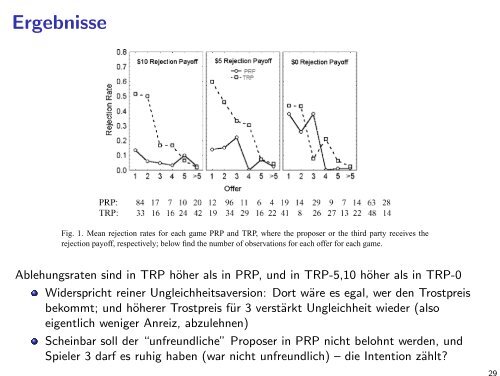Sequentielle Verteilungsspiele
Sequentielle Verteilungsspiele
Sequentielle Verteilungsspiele
Sie wollen auch ein ePaper? Erhöhen Sie die Reichweite Ihrer Titel.
YUMPU macht aus Druck-PDFs automatisch weboptimierte ePaper, die Google liebt.
Ergebnisse<br />
180 Y. Bereby-Meyer, M. Niederle / J. of Economic Behavior & Org. 56 (2005) 173–186<br />
Fig. 1. Mean rejection rates for each game PRP and TRP, where the proposer or the third party receives the<br />
rejection payoff, respectively; below find the number of observations for each offer for each game.<br />
Ablehungsraten reduce thesind payoff inof TRP the least höher well off alsplayer. in PRP, In ourund games inthe TRP-5,10 proposer has höher no such als moves in TRP-0<br />
available; hence this of reciprocity will not have any impact on our games.<br />
Widerspricht reiner Ungleichheitsaversion: Dort wäre es egal, wer den 9<br />
Trostpreis<br />
bekommt; und höherer Trostpreis für 3 verstärkt Ungleichheit wieder (also<br />
eigentlich 6. Results weniger Anreiz, abzulehnen)<br />
Scheinbar soll der “unfreundliche” Proposer in PRP nicht belohnt werden, und<br />
We first focus on the behavior of the responder. Table A.1 in the Appendix A 10 shows<br />
Spieler<br />
the number<br />
3 darf<br />
of<br />
es<br />
observations<br />
ruhig haben<br />
for each<br />
(war<br />
offer<br />
nicht<br />
in each<br />
unfreundlich)<br />
game.<br />
– die Intention zählt?




